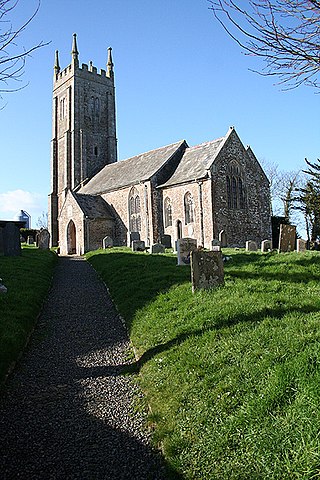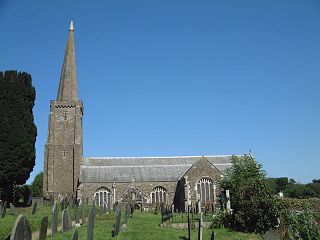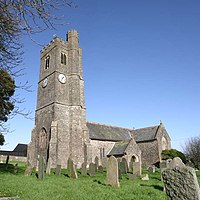
Broadhempston is a village, parish and former manor in Devon, England, situated about 4 miles north of Totnes. It is now administered by Teignbridge District Council. According to the 2001 census the parish contained 257 houses with a population of 641.

Mortehoe is a village and former manor on the north coast of Devon, England. It lies 10 miles north-west of Barnstaple, near Woolacombe and Lee Bay, and is sited in a valley within the hilly sand-dune-like land behind Morte Point, almost directly above Woolacombe. The parish population at the 2011 census was 1,637.

Chittlehampton is a village and civil parish in the North Devon district of Devon, England. The parish is surrounded clockwise from the north by the parishes of Swimbridge, Filleigh, South Molton, Satterleigh and Warkleigh, High Bickington, Atherington, and Bishop's Tawton. According to the 2001 census, the parish had a population of 820. There is an electoral ward of the same name. In the 2011 census this ward had a population of 2,255.

Bondleigh is a village and civil parish in the West Devon district of Devon, England, on the River Taw, north of North Tawton. According to the 2011 census it had a population of 167.

Willand is a village and civil parish in Mid Devon, England. It is about 19 km (12 mi) north of Exeter and 2.4 km (1.5 mi) north of Cullompton. In 1991 the population was 3750 although recently this has grown considerably. The National Grid reference for the centre of the area is ST037110. Willand is a major part of Lower Culm electoral ward. The ward population at the 2011 Census was 5,808. The parish is surrounded, clockwise from the north, by the parishes of Halberton, Uffculme and Cullompton.

Meavy is a small village, civil parish and former manor in the English county of Devon. Meavy forms part of the district of West Devon. It lies a mile or so east of Yelverton. The River Meavy runs near the village. For administrative purposes the parish is grouped with the parishes of Sheepstor and Walkhampton to form Burrator Parish Council, and for electoral purposes it is grouped with the same two parishes to form Burrator Ward.

Umberleigh is a former large manor within the historic hundred of (North) Tawton, but today a small village in North Devon in England. It used to be an ecclesiastical parish, but following the building of the church at Atherington it became a part of that parish. It forms however a part of the civil parish of Chittlehampton, which is mostly located on the east side of the River Taw.

Holbeton is a civil parish and village located 9 miles south east of Plymouth in the South Hams district of Devon, England. At the 2001 census the parish had a population of 579, down from 850 in 1901. By 2011 it had increased to 619.

Dunchideock is a small civil parish on the north eastern slopes of the Haldon Hills in Teignbridge, Devon, England. It covers an area of 392 hectares and lies about 6 km (3.7 mi) south-west of Exeter and 11 km (6.8 mi) north-east of Bovey Tracey. The parish, with a population of 262 in 2001, lacks a compact village, but consists of scattered dwellings. It is surrounded clockwise from the north by the parishes of Holcombe Burnell, Ide, Shillingford St. George, Kenn, and Doddiscombsleigh.

Sir John Basset, of Tehidy in Cornwall and of Umberleigh in Devon was Sheriff of Cornwall in 1497, 1517 and 1522 and Sheriff of Devon in 1524. Although himself an important figure in the West Country gentry, he is chiefly remembered for his connection with the life of his second wife and widow Honor Grenville, who moved into the highest society when she remarried to Arthur Plantagenet, 1st Viscount Lisle KG, an illegitimate son of King Edward IV, and an important figure at the court of King Henry VIII, his nephew.

St Andrew's Church is a ruined church in South Huish, South Hams, Devon, England. It is recorded in the National Heritage List for England as a designated Grade II* listed building, and is under the care of the Friends of Friendless Churches.

Sir Arthur Bassett (1541–1586) was a member of the prominent west-country Basset family and was MP for Barnstaple in 1563 and Devon in 1572. He served as JP for Devon from 1569 to his death and as Sheriff of Devon in 1574–5. He was knighted in 1575. He had been appointed deputy warden of Stannaries by 1580.

The Chapel of the Holy Trinity at Umberleigh is a ruinous mediaeval chapel in north Devon, England, largely demolished according to Lysons (1822) in about 1800. It stands next to Umberleigh House, the manor house of Umberleigh, which still survives in the form of a large Georgian farmhouse. The ruins together with the adjoining Umberleigh House were granted a Grade I listed status on 25 February 1965. According to Tristram Risdon (d.1640) the Devon historian, the site was originally a royal palace of the Saxon King Athelstan and was later a mediaeval mansion house by successive inheritance of the Solery, Champernoun, Willington, Beaumont and Bassett families. The chapel, manor house and estate of 400 acres with 7 cottages is today the property of the Andrews family, which purchased the freehold of the property in 1917 but had been long-standing tenants of the Bassett family from about 1840. The south wall of the chapel survives and today forms the back wall of an outbuilding used for general storage.

Whitechapel is an ancient former manor within the parish of Bishops Nympton, in north Devon. It was the earliest known residence of the locally influential Bassett family until 1603. The core of the present manor house is late 16th or early 17th century, with later additions and alterations, and was classed as Grade I listed on 9 June 1952.

Shirwell is a village, civil parish and former manor in the local government district of North Devon, in the county of Devon, England. It was also formerly the name of a hundred of Devon. The village lies about 3.5 miles north-east of the town of Barnstaple, to the east of the A39 road to Lynton. The parish is surrounded clockwise from the north by the parishes of East Down, Arlington, Loxhore, Bratton Fleming, Goodleigh, Barnstaple, West Pilton and Marwood. In 2001 its population was 333, little changed from the 1901 figure of 338.
The Manor of Shirwell was a manor in North Devon, England, centred on the village of Shirwell and largely co-terminous with the parish of Shirwell. It was for many centuries successively the seat of two of the leading families of North Devon, the Beaumonts and their heirs the Chichesters of Raleigh, Pilton, both of which families were seated at the estate of Youlston within the manor of Shirwell. The manor house which survives today known as Youlston Park is one of the most architecturally important historic houses in North Devon and exists largely in its Georgian form, but retains many impressive late 17th-century interiors.

Loxhore is a small village, civil parish and former manor in the local government district of North Devon in the county of Devon, England. The parish, which lies about five miles north-east of the town of Barnstaple, is surrounded clockwise from the north by the parishes of Arlington, Bratton Fleming and Shirwell. In 2001 its population was 153, down from the 202 residents it had in 1901.

The Church of St Peter ad Vincula is the Church of England parish church for the village of Combe Martin in North Devon in the UK. Possibly built on the site of a Saxon church, construction of the present building began in the 13th-century with additions in the 15th-century and later. It has been a Grade I listed building since 1965. The church comes under the Diocese of Exeter. Pevsner describes the church as "One of the best in the neighbourhood." The church is one of only 15 in England dedicated to St Peter ad Vincula, after the basilica of San Pietro in Vincoli in Rome.

The Church of St Peter is the 13th-century Anglican parish church for the village of Shirwell in North Devon. It is a Grade I listed building and comes under the Diocese of Exeter. The family church of the Chichester Family who lived locally, the aviator and sailor Sir Francis Chichester, who was born in Shirwell, is buried in the churchyard.



















